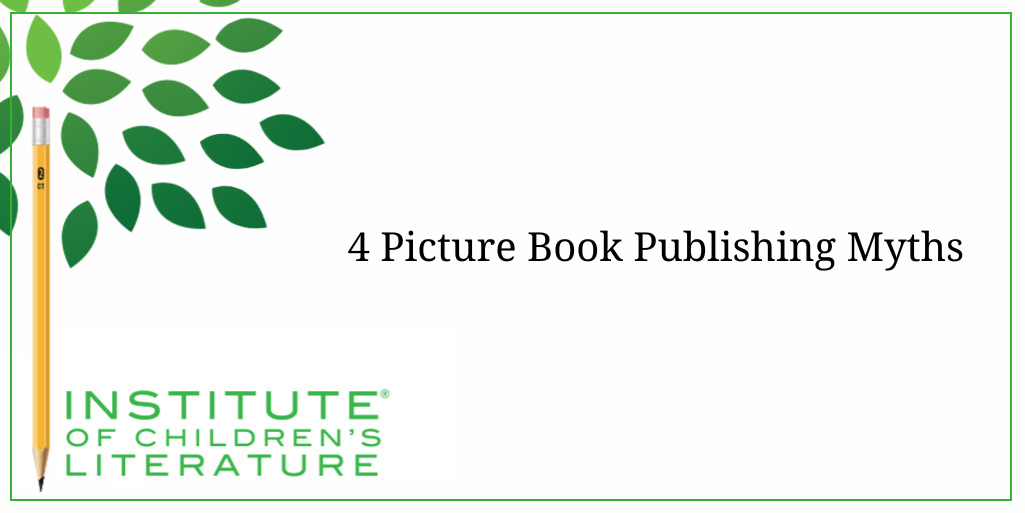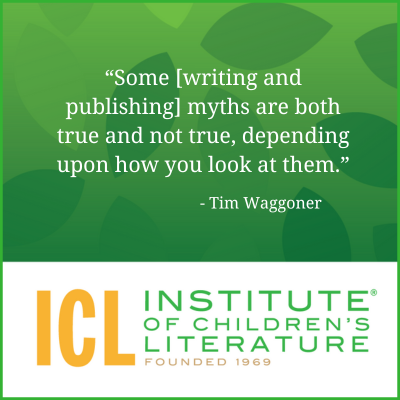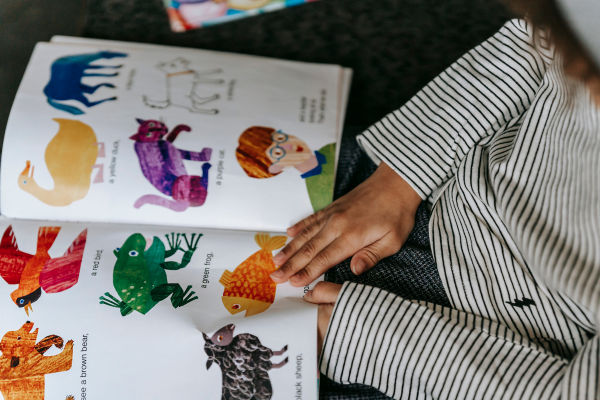
5 Ways Writers Can Prep for 2025 Goal Setting
Before we roll on to the new writing year, let’s harness our optimism for the blank slate before us and prepare for our 2025 Goal Setting just for writers.

We’re going to close out the year by talking about writing and publishing myths. These are those “rules” or “truths” that are believed by writers that are either not true or not entirely true. Some are based on “common sense.” When writers look at a situation, this idea seems to make sense but fails to consider the breadth and complexity of publishing today. Some don’t even make much sense but linger as myths simply because they’ve been told over and over.

So, this month we’ll strap in for a wild ride through myth-busting in various areas of publishing. And since we’re primarily children’s writers here, let’s start where many (if not most) children’s writers begin: picture books.
Virtually everyone I know who has written picture books successfully can tell you about the time (or times) when someone asked them why they don’t graduate from children’s writing and write for adults. This is sometimes couched as a compliment. The person will say the author writes really well, so why not write for adults or write a real book?
Most of the time, the people who ask these questions are working with twin myths. One is that picture books are short so they must be quick and easy to write. The other is that children are less discerning than adults, so writing for them takes less effort and skill. As it turns out, neither of these beliefs are accurate. Children are surprisingly demanding when it comes to picture books they love and ask for again and again. And the writing of a book that succeeds is far more difficult than it looks at first glance.

Author Anna Dewdney said of picture books, “They are very complicated books. You are working with a very tight format, and they become like haiku. Until people have tried and tried to get published, they just don’t understand.”
Suppose authors manage to do all the difficult parts of writing the book, does it get easier then? No, not so much. The picture book author then enters one of the most competitive arenas to make a connection to be published. Anna Dewdney said that an editor once told her that out of a slush pile of 15,000 manuscripts, the odds were that only one would be published.
Of course, meeting all the writing demands pushes the odds up that your book will be the one published, but this is still not a writing choice for the faint-hearted, and yet it’s the area most brand new children’s writers shoot for, mostly because they don’t know what they’re tackling.
Another thing that makes it difficult for new writers to sell their picture book writing efforts is believing this second myth: that they need to be an illustrator, or they need to find an illustrator. Thankfully, this is not true. Children’s picture book illustration is another one of those deceptively easy-looking skills, especially if you look at picture books with bright illustrations based on simple shapes. “I could do that,” new writers think, and they are often wrong.

Because book illustration is hard, publishers don’t expect writers to know anything about it. They don’t expect you to draw. They don’t expect you to know professional illustrators. And they don’t expect to see the drawings of an untrained artist. They don’t need you involved in the illustration at all. They will hire a professional for that job. What they want from you is a well-written story in a few words that sounds great when read aloud and will hold up under repeat reading.
This is a tricky myth. Many picture books by experienced writers do rhyme. This is because kids love rhyming picture books. Unfortunately, it is much harder to write a rhyming picture book well than it is to write a strictly prose picture book well. As a result, most publishers who are open to direct submissions won’t look at rhyming picture books. It isn’t that they wouldn’t like to see an amazing, perfect, stupendous rhyming picture book. It’s simply that they know they have almost zero chance of getting one of those in direct submission.
Rhyming picture books sound easy enough. They’re short. The lines are short. And words at the end of the lines must rhyme. Easy, right? Only it’s not so easy. Rhyming picture books must also:
I’ve read a great many rhyming picture book manuscripts when I’ve worked one-on-one with writers, and I’ve noticed that when I do run across someone who has a decent sense of meter and rhyme, they rarely bring story along for the ride. The books tend to be a list of actions, not a story. And they nearly always have weak endings. Since they don’t have a plot, they have no destination they’re writing towards. Thus, the manuscript simply ends with no real sense of completion or satisfaction.
In truth, a good story is far more important than rhyme. Some publishers who publish most of their books in several languages for sale all over the world will specifically avoid rhyming stories because they are so difficult to translate. And the rhyme and meter rarely work when translated into a new language. So, if you don’t write in rhyme, you’re starting off in a much easier place than if you feel like you must.
Self-publishing is a complex subject. If a writer has a strong following, clear name recognition, and a platform that allows the writer to reach their fans easily, that writer is probably going to do well in self-publishing, especially if they publish novels in one of genre that does well via e-book, namely romance (especially paranormal romance), fantasy, horror, and mystery (especially cross-genre mystery). You may have noticed that picture books weren’t on that list. This is because it is extremely difficult to sell self-published picture books.

Another issue with self-published picture books is that when you get into self-publishing, you do have to come up with the illustrations. And most new writers who self-publish end up with illustrations that simply cannot compete with traditionally published books. Plus, if you’re printing your self-published books, you add the additional expense of printing (which is huge) and storage. Many self-published picture books have poor production values because picture books are expensive to print. And the expense continues, including the cost in time you’ll need to spend selling the books directly to buyers since most self-published picture book sales are hand sales.
Again, this changes if the self-published author has already built a following. The expenses are still there, but at least the author may find bookstores to carry the book or may have a platform to drive sales for their book. They will still probably see fewer sales than a traditionally published book at a mid-sized publisher, but they may not have to turn their garage into book storage.
Still, if you aren’t concerned about how many sales you get, and a few dozen to one hundred will make you happy, then self-publishing a picture book still may be an option, though not a lucrative one. This is especially true if you’re publishing a passion project, a book your mom wrote (for instance), or a book about a local landmark you’ve always loved (though you might want to look into regional presses first). There are reasons that can make self-publishing a viable choice, but none of them are because self-publishing is just a better choice for picture book publishing overall.
Were any of those picture book myths surprising? If they left you feeling a little blue about the idea of writing picture books, remember that they are only one option from a vast array of choices. It may be that the idea you had for a picture book will be better suited for a short story or a chapter book. Or you may find that you can create the picture book of your dreams. People succeed as picture book writers every day. It takes work, skill building, and patience, but if you go into it with no myths clinging to you, you’ll greatly increase your chance of success.
And that’s no myth.
With over 100 books in publication, Jan Fields writes both chapter books for children and mystery novels for adults. She’s also known for a variety of experiences teaching writing, from one session SCBWI events to lengthier Highlights Foundation workshops to these blog posts for the Institute of Children’s Literature. As a former ICL instructor, Jan enjoys equipping writers for success in whatever way she can.

Before we roll on to the new writing year, let’s harness our optimism for the blank slate before us and prepare for our 2025 Goal Setting just for writers.

Writers can be thin-skinned when it comes to getting feedback on their work. Let’s look at 4 ways to positively deal with constructive criticism!

Rejection is part of the territory when it comes to being a writer. Today we offer reflection for writers to help redirect your efforts after a rejection.
1000 N. West Street #1200, Wilmington, DE 19801
© 2024 Direct Learning Systems, Inc. All rights reserved.
1000 N. West Street #1200, Wilmington, DE 19801
© 2024 Direct Learning Systems, Inc. All rights reserved.
1000 N. West Street #1200, Wilmington, DE 19801
© 2024 Direct Learning Systems, Inc. All rights reserved.
1000 N. West Street #1200, Wilmington, DE 19801
© 2025 Direct Learning Systems, Inc. All rights reserved.
1000 N. West Street #1200, Wilmington, DE 19801
©2025 Direct Learning Systems, Inc. All rights reserved. Privacy Policy.
2 Comments
This is a great article and I was familiar with most of the information. I have written quite a few stories that I would love to have traditionally published but it’s difficult to find a publisher that will take unsolicited manuscripts. I feel quite discouraged because I have put in quite a bit of time and effort into writing.
Hi Angela. If you’re looking for a picture book publisher who takes unsolicited manuscripts, and you already have a good market guide, you might want to check out this list. It doesn’t mention every publisher who takes unsolicited, but it does cover most of the ones takes PICTURE BOOK submissions without an agent. https://bitsykemper.com/publishers/ — Jan